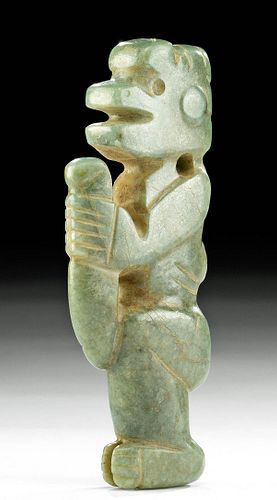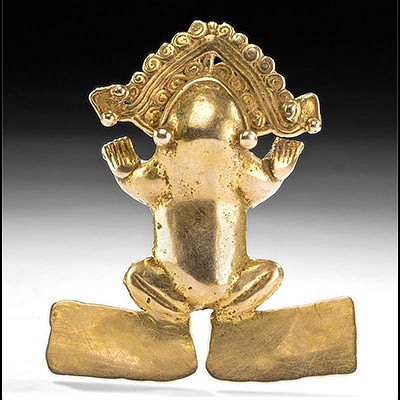Costa Rican Jade Pendant of Fisherman - Rare Style
Lot 95
About Seller
Artemis Gallery
686 S Taylor Ave, Ste 106
Louisville, CO 80027
United States
Selling antiquities, ancient and ethnographic art online since 1993, Artemis Gallery specializes in Classical Antiquities (Egyptian, Greek, Roman, Near Eastern), Asian, Pre-Columbian, African / Tribal / Oceanographic art. Our extensive inventory includes pottery, stone, metal, wood, glass and textil...Read more
Estimate:
$5,000 - $7,000
Absentee vs Live bid
Two ways to bid:
- Leave a max absentee bid and the platform will bid on your behalf up to your maximum bid during the live auction.
- Bid live during the auction and your bids will be submitted real-time to the auctioneer.
Bid Increments
| Price | Bid Increment |
|---|---|
| $0 | $25 |
| $300 | $50 |
| $1,000 | $100 |
| $2,000 | $250 |
| $5,000 | $500 |
| $10,000 | $1,000 |
| $20,000 | $2,500 |
| $50,000 | $5,000 |
| $100,000 | $10,000 |
| $200,000 | $20,000 |
About Auction
By Artemis Gallery
Aug 13, 2020
Set Reminder
2020-08-13 10:00:00
2020-08-13 10:00:00
America/New_York
Bidsquare
Bidsquare : Fine Antiquities, Ethnographic & Fine Art
https://www.bidsquare.com/auctions/artemis-gallery/fine-antiquities-ethnographic-fine-art-5415
Features classical antiquities, ancient and ethnographic art from cultures encompassing the globe. Egyptian, Greek, Roman, Etruscan, Near Eastern, Asian, Pre-Columbian, Native American, African / Tribal, Oceanic, Spanish Colonial, Russian, Fine Art, so much more! Artemis Gallery info@artemisgallery.com
Features classical antiquities, ancient and ethnographic art from cultures encompassing the globe. Egyptian, Greek, Roman, Etruscan, Near Eastern, Asian, Pre-Columbian, Native American, African / Tribal, Oceanic, Spanish Colonial, Russian, Fine Art, so much more! Artemis Gallery info@artemisgallery.com
- Lot Description
Pre-Columbian, Central America, Costa Rica, ca. 1 to 800 CE. An incredibly rare form of jade axe pendant, a sacred class of artifact found in ancient Costa Rican tombs. Carved three dimensionally, it is in the form of a profile figure with an anthropomorphic body, an avian head, and holding a fish by the tail in its raised arms. The figure stands in a slight crouch, with its arms raised to display its prize; the fish's face is clearly visible carved on one side of the pendant. The head has a bulging, disc-like eye and a crest above its beak-like mouth. This figure may be a shaman taking on the powers of a bird in order to capture fish! An opening at the neck would have allowed to be to worn. Size: 1.9" W x 4.9" H (4.8 cm x 12.4 cm)
The value of jade for people in ancient Central America lay in its symbolic power: its color seems to have been associated with water and vegetation and jade items were often given to the dead; north of Costa Rica, the Maya would place jade beads in the mouths of the dead. Many scholars have argued that the demand for jadeite contributed to the creation of long distance trading networks and to the rise of urban centers in ancient Mesoamerica. Jade would have come to Costa Rica in the form of axe-blades (celts) that would then be worked by local artisans into pendants like this one. The exoticism of stone that had traveled so far probably contributed to the value of these objects in ancient Costa Rica.
Provenance: ex-Craig Hendrix collection, South Carolina, USA; ex-Charles Craig Jr. collection, Costa Rica, acquired in the 1960s and 1970s
All items legal to buy/sell under U.S. Statute covering cultural patrimony Code 2600, CHAPTER 14, and are guaranteed to be as described or your money back.
A Certificate of Authenticity will accompany all winning bids.
We ship worldwide and handle all shipping in-house for your convenience.
#154102Excellent condition with very light pitting and scratching on the surface.Condition
- Shipping Info
-
All shipping is handled in-house for your convenience. Your invoice from Artemis Gallery will include shipping calculation instructions. If in doubt, please inquire BEFORE bidding for estimated shipping costs for individual items.
-
- Buyer's Premium



 EUR
EUR CAD
CAD AUD
AUD GBP
GBP MXN
MXN HKD
HKD CNY
CNY MYR
MYR SEK
SEK SGD
SGD CHF
CHF THB
THB














